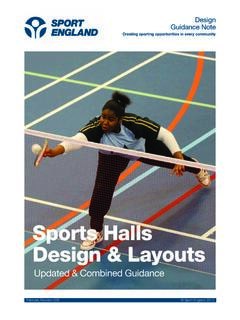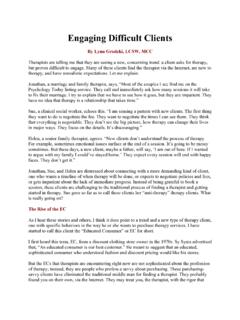Transcription of Sports Participation and Ethnicity in England. National ...
1 Sports Participation and Ethnicity in England National Survey 1999/2000 Headline Findings Nick Rowe/Ross Champion Sport England Sport England Research 16 Upper Woburn Place October 2000 London SE/1073 WC1H 0QP Sport England Tel: 020 7273 1500 Fax: 020 7383 5740 Email: 1 Sports Participation and Ethnicity in England 1999/2000 Headline Findings Executive Summary The survey This survey, carried out by the Office for National Statistics (ONS) on behalf of Sport England, provides for the first time National statistics on the levels of Participation in sport, previous sporting experiences and sporting aspirations of people from ethnic minority communities in England.
2 The survey is part of Sport England s continuing commitment to better understand the extent and causes of inequity in sporting opportunities for certain groups in the population and ways to overcome them. The findings from the survey have relevance to all Sport England s areas of work but are especially important for its Active Communities programme, which seeks to extend sporting opportunities for all. The methods The findings are based on a random sample of 3,084 adults (aged 16 years and over) from non white ethnic minority communities who were interviewed in their homes during the period June 1998 to March 2000. Respondents were identified initially through ONS s large scale Labour Force Survey and its monthly Omnibus Survey. The survey was carried out to the highest quality standards in relation to sampling, survey administration and analysis.
3 The results of the survey are comparable with National population averages obtained from the Sports Participation questions included in the 1996 General Household Survey (GHS). It is the comparison with National averages that enables over or under-representation of the levels of Participation in sport by ethnic minority groups to be established and priority areas for action to be identified. Unless specified otherwise, Participation in sport is defined as having taken part in sport or physical activities on at least one occasion in the previous four weeks excluding walking. All methods of classification inevitably simplify the diversity that exists between different groups and within the groups themselves. Large-scale surveys of this kind, however, require categorisations to be made in order that results can be presented in a way that is statistically acceptable.
4 For the purposes of the survey respondents were classified in the following ethnic groups : Black Caribbean ; Black African ; Black Other ; Indian ; Pakistani ; Bangladeshi ; Chinese ; and Other non white . This enabled comparison with the GHS. 2 The findings What are the overall levels of Participation in sport by ethnic minorities and how do these compare with the population as a whole? For ethnic minority groups overall the Participation rate in sport is 40% compared with a National average of 46%. The overall Participation rate for male ethnic minorities is 49% compared with a National average for men of 54% and for female ethnic minorities it is 32% compared with a National average for all women of 39%. On average Black Caribbean (39%), Indian (39%) and in particular Pakistani (31%) and Bangladeshi (30%) populations have rates of Participation in sport below those of the National average (46%).
5 Only the Black Other group (60%) has Participation rates higher than found in the population as a whole. Black African men (60%) and Black Other men (80%) have higher Participation rates than the National average for all men (54%) while Indian (47%), Black Caribbean (45%), Bangladeshi (46%) and Pakistani (42%) men are less likely to participate in sport than men generally. National Participation rates for women (39%) were matched or exceeded by women from Black Other (45%), Other (41%) and Chinese (39%) ethnic groups while women who classified themselves as Black Caribbean (34%), Black African (34%), Indian (31%), and Bangladeshi (19%) had Participation rates below the National average for all women. The gap between men s and women s Participation in sport is greater amongst some ethnic minority groups than it is in the population as a whole.
6 The inequality gap between men and women nationally is 15 percentage points whereas for the Black Other ethnic group it is 35 points (although overall this is a relatively high participant group), for Bangladeshis it is 27 points, Black Africans 26 points, and Pakistanis 20 points. Which Sports do different ethnic minority groups take part in and how do they compare with National averages? Levels of Participation in walking amongst ethnic minorities are significantly below those for the population as a whole. At the lowest end, only 19% of the Bangladeshi population takes long walks regularly compared with 44% of the population as a whole. These low activity levels are of particular concern when viewed in the context of the high incidence of heart disease, diabetes, and obesity amongst certain ethnic groups (all health problems in which regular physical activity has been proven to have a positive impact).
7 3 For all groups, apart from the Bangladeshi population, keep fit/aerobics/yoga features as the second most popular activity and this is boosted in particular by its popularity amongst women. Keep fit is by far the most popular activity after walking for women from all ethnic groups (keep fit ranks as the third most popular sport amongst the population as a whole and tied second amongst all women). Swimming has a lower ranking in Participation amongst most ethnic minority groups (from as low as seventh in the case of the Black Caribbean population and sixth in the case of Black Africans and Black Others ) than it does amongst the population as a whole where it ranks second in popularity behind walking. Overall ethnic minorities are less likely to take part in swimming than the population as a whole.
8 Black Caribbean, Black African and Black Other men have particularly low levels of Participation , reaching as low as 2% for Black Other men which is 11% less than for men in the population as a whole. Women from Pakistani, Black Caribbean and Bangladeshi ethnic groups have particularly low levels of Participation in swimming, as low as 5% for Pakistani women compared with a National average of 17% for all women. Participation in football amongst males from ethnic minority groups is relatively high. This is particularly the case amongst Black males with Participation rates as high as 31% amongst the Black Other ethnic group, which is three times the National average (10%). Given the publicity about the lack of representation of Asian footballers at the highest levels it is interesting to see that Participation amongst these groups is around the National average and exceeds it in the case of Pakistani men (16%).
9 There are a number of instances where Sports have relatively high levels of Participation amongst certain ethnic minority groups. These include: Men Weight training amongst Black males with Participation rates of 23% for the Black Other group, and 12% for both Black Caribbeans and Black Africans which compares with 9% for the population as a whole. Running/jogging amongst Black Other (18%), and Black African men (15%), which is higher than for males generally (7%). Self-defence/martial arts by Black Other males (11%) and Black Caribbeans (6%) which compares with an average for all men of 1%. Badminton by Chinese men (17%), which compares with an average of 3% for all men. Cricket by Pakistani (10%), Black Other (8%), and Indian (6%) men, which compares with the average for all men of 2%.
10 Basketball amongst Black Caribbean (4%) and Black African (4%) males which compares with a population average for men of 1%; and Carram-board amongst Bangladeshi men (4%), which compares with less than 1% in the male population as a whole. 4 Women Running/jogging amongst Black African (11%), Black Caribbean (4%) and Other (4%) ethnic group women, which compares with the average for all women of 2%. Weight training by Black Caribbean women (7%) which compares with a National average of 3% Self-defence/martial arts by Chinese women (3%), which compares with a National average of less than one percent for women generally. Basketball amongst Black Caribbean women (3%), which compares with an average Participation rate of less than one percent for all women.
















